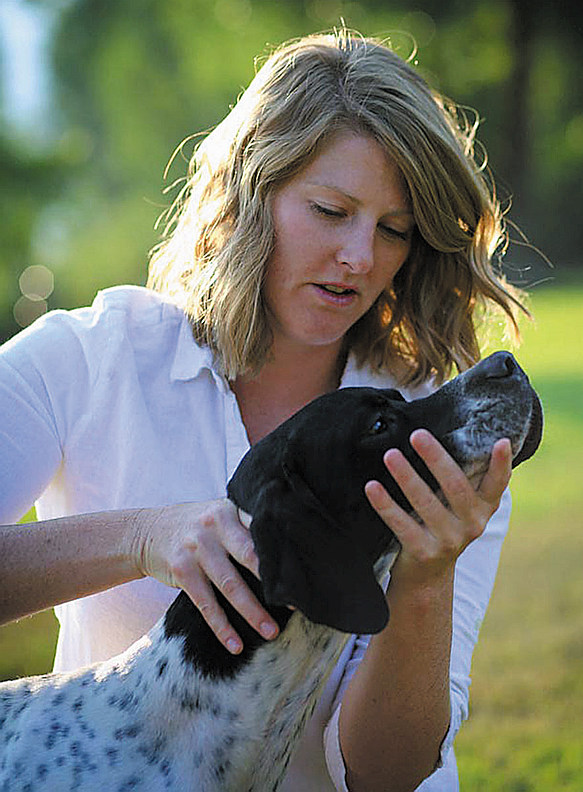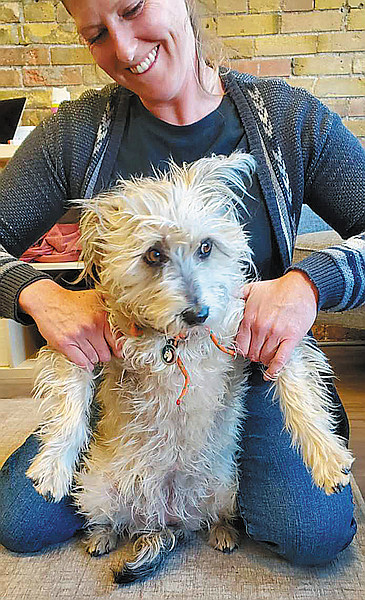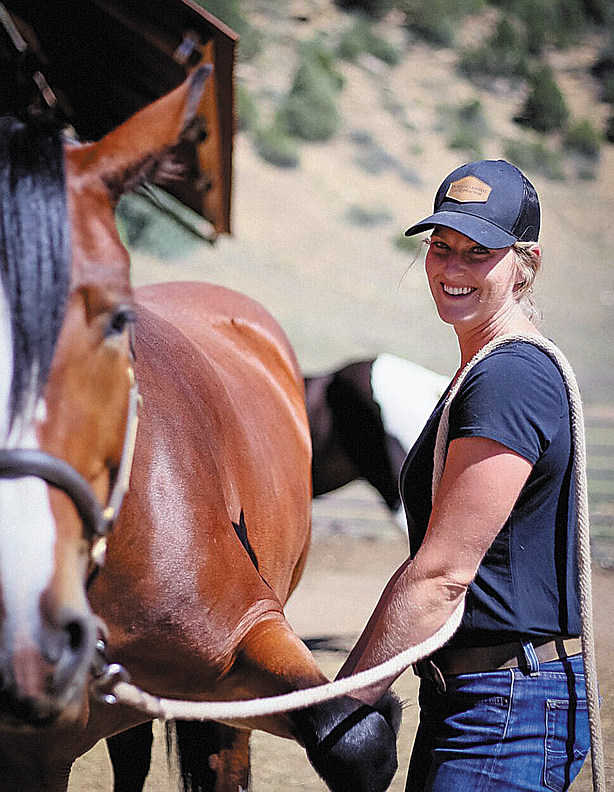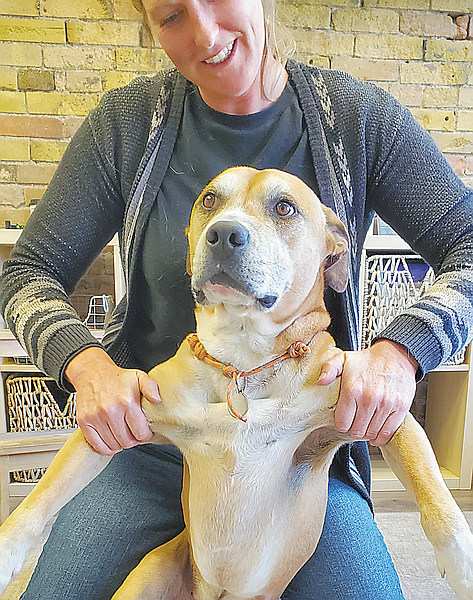By Solana Kline — {A lifelong dog-rescue advocate and avid back-country motorcycle adventure rider}

Being a bipedal human myself, it has always been a curiosity to see four-legged ambulation, to picture the stress on the middle of the spine or shoulders or hips if the muscles and alignment are not in perfect synchronicity. Most times, our companions are so tough that it can be hard to tell if they are in pain unless they are dealing with an acute injury.
What makes this increasingly more difficult is that most humans don’t speak perfect four-legger and our four-legger’s don’t often speak in complete human sentences. Their communication of pain, discomfort, or injury often takes less verbal forms (see tinyurl.com/ydk45ttn).
Other times of course, the pain is excruciating, and we can expect some yowling like when Mickey decided to tail a porcupine. He ended up with a mouthful of quills resembling a sea anemone!
New communication devices are coming onto market, such as the pet communication buttons from Fluent Pet (fluent.pet) that allow our dogs and cats to step on buttons that relay human words. Still, our best bet for helping our pets stay healthy in their bodies is for us humans to be preventative and proactive!

Betty, the Silverback Sausage, is the long body in our crew. She is some mix of terrier that gives her the elongated squirrelin’ spine that earned her the sausage monicker. She’s my first longer-than-usual furry companion. She just started having trembling in her rear legs and sensitivity in her middle-back. This tender place in her back was precisely where her spine takes the impact from her jumping out of the truck or other high squirreling nature-places. And Mr. Mickey’s Pittie/Boxer build wreaked all sorts of havoc on his knees and shoulders. As a grayed middle-aged man now, he’s limping around after just one afternoon of forest sprinting.
We happened to be traveling up to Durango, CO and did a little research to locate a chiropractor. Low and behold, we found the most incredible human and animal chiropractor, Dr. Iris!
Dr. Iris Davidson, DC took over Durango Animal Chiropractor to work with small-animal, equine, and human (durangoanimalchiropractor.com). She fit us right in, and all three of us got chiropractic adjustments together as a pack!
Within a day, Betty’s spine pain was gone, the Silverback Sausage agile as ever and terrorizing fleeing ground squirrels. Mickey was back to his pain free ambulation! And while the pups sure wondered what the heck was going on during treatment, their body relief immediately after treatment was undeniable as they romped around Dr. Iris’ office and snuggled in next to her on the floor in gratitude.
Dr. Iris was wonderful to take an interview to share a bit about the benefits of chiropractic for our four-legged companions:
Can you tell us a little about animal chiropractic and how you got into it?

Dr. Iris: “ As Doctors of Chiropractic, we are trained in not only understanding all body systems, but how to utilize an adjustment to correct an area that has become ‘disconnected.’ An adjustment not only restores proper biomechanical motion to a joint, it can provide pain relief, and sends a signal to the brain that has the ability to create homeostatic change in the body.
The other profound benefit (among many) of an adjustment is the ability to help regulate the nervous system by stimulation of the parasympathetic (rest and digest) nervous system.
One of the most impactful memories I had at that time was witnessing a Dachshund enter the office in his owner’s arms, unable to use his hind legs. Within a few adjustments, the dog was back to walking normally. I was astonished by the results and my interest was piqued.
My journey to become an animal chiropractor stemmed solely from a deep desire to have a career path that worked with animals. Veterinary school was an option initially, but there were aspects about the field that left me feeling removed from animals; it felt like doing things TO them rather than WITH them.
Animal chiropractic to me is a practice of observing posture and gait, feeling the tone of the body, and then delivering an adjustment by working collaboratively to create change. This is most obvious when working with horses; not only are they much larger than we are, but it takes their willingness to participate in the adjustment to create positive change. It’s a dance, it takes feel, and it takes timing, which ironically are all ways to describe good horsemanship.”
How does chiropractic help humans and four-legged patients?
Dr. Iris: “What I enjoy most working with the animals is how quickly they respond to the work. Unlike us humans, animals operate in the present, which means they do not dwell on the past, nor do they worry about the future. “Mental debris” as I call it, is a major limiting factor to our health and well-being [as humans].
Animals are also incredibly expressive during and after an adjustment, and give you signs that their nervous system has been affected. Horses will lick and chew, take a deep breath, yawn, look sleepy and relaxed, and sometimes roll after an adjustment. These are all signs of parasympathetic stimulation (rest and digest) which is the state of being that allows healing to occur.
Similarly, dogs will do a full body shake after being adjusted which indicates a sort of integration that humans would benefit from if we literally “shook things off,” rather than storing and locking that information into our physical being.
I also enjoy working with animals that veterinarians have referred as a last-ditch effort. Many times, I see a dog presenting with a limp, change in posture, or behavioral change that does not appear to have clinical indications that respond to traditional medical treatment. These animals tend to respond very well to chiropractic care, and it is a joy to help the animals first and foremost, but also to see the amazement when owners witness a solution that does not require drugs or surgery.”
Do you have any suggestions for us humans getting more in tune with our pet’s health needs?

Dr. Iris: “Spend time hanging out with your animal and observing their body language. What are their ears doing? Tail? Are their eyes soft and relaxed, or dilated and tense? Is your horse’s jaw tight or relaxed? Does your animal’s skin twitch or jump when you pet them or run your hands over their body? These are just a few basic prompts that show how much information you can gather from your animal that is not as overt and seeing a lameness or a limp.
Another way to consider your animal is by empathizing with their lifestyle and level of fitness. Many of the issues I work with are dogs or horses that have been asked to do too much too soon, or simply more than they are physically prepared for. This results in injury or discomfort in their body that can then result in a behavioral issue or chronic pain.
Animals are born athletes, but just like us, you would never run a marathon off the couch, and it’s not fair to expect your animal to do the same. Be considerate and aware of their limitations based on age, fitness level, and environmental factors.
Be an advocate for your animal and set them up for success, not failure.”
Until next time, happy trails and happy tails!
Special thanks to Dr. Iris! If you want to schedule or find out more, give her a call at 720-937-4342 or check out her website at durandurangoanimalchiropractor.com! To locate animal chiropractors across the US go to: AVCA.org or IVCA.org
~Solana, Silverback Sausage & Mr. Mickey~

